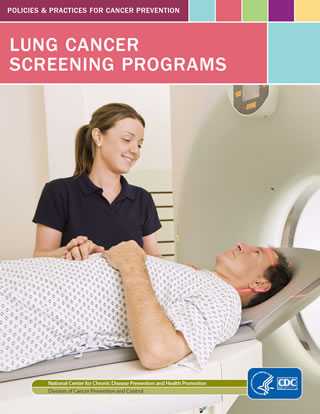What Screening Tests Are There?

Policies and Practices for Cancer Prevention: Lung Cancer Screening Programs [PDF-2.6MB] describes how grantees of CDC’s National Comprehensive Cancer Control Program can increase awareness about lung cancer screening among people who are at high risk.
Screening means testing for a disease when there are no symptoms or history of that disease. Doctors recommend a screening test to find a disease early, when treatment may work better.
The only recommended screening test for lung cancer is low-dose computed tomography (also called a low-dose CT scan, or LDCT). In this test, an X-ray machine scans the body and uses low doses of radiation to make detailed pictures of the lungs.
Who Should Be Screened?
The U.S. Preventive Services Task Force recommends yearly lung cancer screening with LDCT for people who—
- Have a history of heavy smoking, and
- Smoke now or have quit within the past 15 years, and
- Are between 55 and 80 years old.
Heavy smoking means a smoking history of 30 pack years or more. A pack year is smoking an average of one pack of cigarettes per day for one year. For example, a person could have a 30 pack-year history by smoking one pack a day for 30 years or two packs a day for 15 years.
Risks of Screening
Lung cancer screening has at least three risks—
- A lung cancer screening test can suggest that a person has lung cancer when no cancer is present. This is called a false-positive result. False-positive results can lead to follow-up tests and surgeries that are not needed and may have more risks.
- A lung cancer screening test can find cases of cancer that may never have caused a problem for the patient. This is called overdiagnosis. Overdiagnosis can lead to treatment that is not needed.
- Radiation from repeated LDCT tests can cause cancer in otherwise healthy people.
That is why lung cancer screening is recommended only for adults who have no symptoms but who are at high risk for developing the disease because of their smoking history and age.
If you are thinking about getting screened, talk to your doctor. If lung cancer screening is right for you, your doctor can refer you to a high-quality treatment facility.
The best way to reduce your risk of lung cancer is to not smoke and to avoid secondhand smoke. Lung cancer screening is not a substitute for quitting smoking.
When Should Screening Stop?
The Task Force recommends that yearly lung cancer screening stop when the person being screened—
- Turns 81 years old, or
- Has not smoked in 15 years, or
- Develops a health problem that makes him or her unwilling or unable to have surgery if lung cancer is found.
Lung Cancer Screening Guidelines and Recommendations
The Lung Cancer Screening Guidelines and Recommendations chart [PDF-76KB] compares guidelines and recommendations from several organizations regarding groups eligible for screening.
More Information
- U.S. Preventive Services Task Force Lung Cancer Screening Recommendation
- Lung Cancer Screening (National Cancer Institute)
- Implementation of Lung Cancer Screening: Proceedings of a Workshop (The National Academies of Sciences, Engineering, and Medicine)
- Lung Cancer CT Screening Decision Aids for Patients and Health Care Providers (Agency for Healthcare Research and Quality)
- Lung Cancer CT Screening Decision Aid (Created by the University of Michigan)
- Lung cancer screening with low-dose computed tomography for primary care providers
- CDC’s Tips from Former Smokers: Smoking and Cancer
- Fact sheet: The Health Consequences of Smoking—50 Years of Progress: A Report of the Surgeon General
- CDC’s Tips from Former Smokers: Quit Guide
- Smokefree.gov (for help with quitting smoking)
- Page last reviewed: August 11, 2016
- Page last updated: July 26, 2017
- Content source:


 ShareCompartir
ShareCompartir